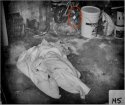Cottonstar
Case Analyst | Expert in Staged Crimes
That was confusing to me as well. I actually stayed on thread topic for a change. This is about how Listen Carefully: Truth and Evidence in the JonBenet Ramsey Case is referring to the 1st floor study. The book is by Cherokee and is the 2016 update of his 2003 work. I thought he was mistaken. Patsy was taken to the 1st floor study because it had a sofa and she could lay down. LA corralled everyone in that study. It wouldn't make sense if the body was placed under the tree and Patsy was in the sun room at the front of the house. Patsy would only be a few feet away from the body. No one would have needed to yell that they found the body because Patsy would have only been a few feet away. Cherokee is referring to the 1st floor study as a solarium.
When the body was found, Patsy was at the back of the house in the 1st floor study where they all should have been. John and Fleet went to the basement. Doug Stein stayed on the first floor and didn't follow John and Fleet into the basement. Reverend Holverstock was in the kitchen making tea. LA was on the 1st floor somewhere near the entry of the house. Everyone else was in the 1st floor study.
"Inexplicably, Patsy Ramsey remained in the solarium. Despite people yelling that JonBenét had been found, she sat motionless for several minutes."
Guild, True Crime Detectives. Listen Carefully: Truth and Evidence in the JonBenet Ramsey Case (Kindle Locations 413-414). ALLFORONE. Kindle Edition.
Doug Stein? Was he a victims advocate? Clearly you don't mean Doug Stine.
cottonstar



